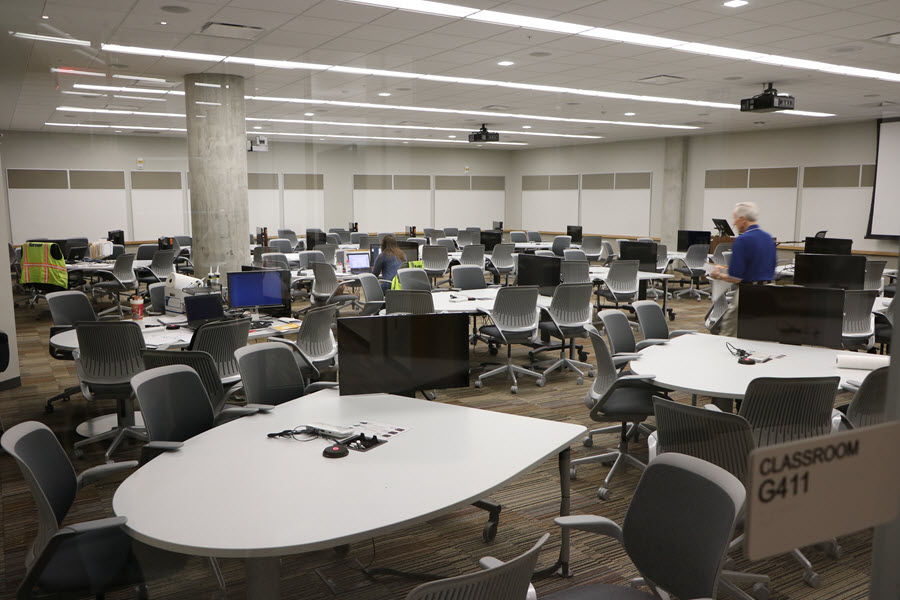By Doug Ward
Learning matters.
That may seem like a truism in the world of education – at least it should be – but it isn’t.
All too often, schools and teachers, colleges and professors worry more about covering the right material than helping students learn. They put information above application. They emphasize the what rather than the why and the how.
In an essay in Inside Higher Ed, Stephen Crew of Samford University makes an excellent case for the importance of learning. He does so with an anecdote about why instructors win teaching awards. For instance, the award-winners may have made sacrificed to pursue their teaching. They may have inspired students or made classes engaging. Perhaps their student evaluations were stellar.
Crew doesn’t dismiss those aspects of teaching. Rather, he says they are simply too shallow.
“The implication is that award-winning teachers are not any more effective at engendering student learning than the rest of us,” Crew writes. “Rather, they devote more time and attention to their teaching and students than we do, or they persevere through greater challenges.”
He asks – rightly – whether those instructors have really helped students learn.
Crew makes an important distinction between learning-driven teaching and information-driven teaching.
Learning-driven teachers help students challenge their thinking, including their metacognitive skills, and demonstrate the importance of deeper understanding. They provide meaningful opportunities for students to apply skills, and then assess students’ understanding and nudge them toward a goal.
Information-driven teaching, on the other hand, is a relatively straightforward affair than nearly anyone can do. It emphasizes accurate, up-to-date content; presentation style; and perhaps the newest technology. “In this approach, the teacher either cannot or should not influence learning beyond the method of delivering information,” Crew writes.
Instructors may be popular and passionate and engaging, Crew says, but if they simply deliver information to students, they haven’t really taught anything.
Angelique Kobler of the Lawrence Public Schools made much the same point last year, saying that if instructors don’t embrace the idea that today’s students learn differently from those even a few years ago, “we will become irrelevant.”
A question that Kobler asked when she spoke with the KU Task Force on Course Redesign still resonates:
Has teaching occurred if learning hasn’t?
Related: What does a learner-centered syllabus look like? (Via Faculty Focus.)
* * * * * * *
Follow-up: The ups and downs of Blackboard
It will be interesting to see how a sale of Blackboard might affect the positive changes I wrote about earlier this week.
Reuters reported on Tuesday that Providence Equity Partners, which owns Blackboard, is looking to sell the company for more than $3 billion. Blackboard, which was created in 1998, had been a public company until Providence bought it and took it private in 2011, paying $1.64 billion and assuming $130 million in debt.
To put the Blackboard price into perspective, here are a couple of comparisons: Forbes estimates the value of the New York Yankees at more than $3 billion. After an initial public offering, the online marketplace Etsy is worth more than $3 billion. So is Donald Trump.
A sale wouldn’t be surprising. Companies like Providence buy lagging companies, revamp them and try to sell them for a profit. Blackboard has become more responsive to customers since Providence took over and hired Jay Bhatt as president and CEO. And news of a possible sale comes just after the completion of Bb World, Blackboard’s annual conference, and the announcement of a slew of changes that would finally pull Blackboard’s design and functionality out of the dial-up web era.
My colleagues in IT say, though, that Blackboard’s promised design changes probably won’t be practical for most schools to adopt for two to three years. That’s because Blackboard is building a new platform for Learn, its learning management system. That new platform lacks many of the integration capabilities the current system has, including grading for discussion boards, integration with SafeAssign, and integration with university enrollment systems.
So adopting the new platform, called Ultra, may depend on how much schools are willing to give up in terms of integration to gain a system that looks and acts like the modern web. Adoption will become even trickier for schools as the company pursues a pricing strategy that resembles that of the automobile industry. A college or university pays one price for the basic Blackboard Learn platform, and then must decide on an array of add-ons that drive up expenses but that contain the most sought-after functions and tools.
For instance, a school has to pay extra for access to the new student app and for the updated instructor grading app. (I wrote on Tuesday that I couldn’t get those apps to work. That’s why.) Blackboard Collaborate requires an extra fee, as does the assessment tool and a host of other digital goodies.
So even as Blackboard promises many positive changes, it is still acting very much like the behemoth it is.
We interrupt this post to report on the teacher draft
That’s right. I said the teacher draft. The comedy team Key and Peele take an ESPN-like look at what the world of teaching might look like if it were elevated to the status of sports: the $80 million salaries, the No. 1 draft pick whose father “lived from paycheck to paycheck as a humble pro football player,” and the “teacher-of-the-year play” in the day’s highlights. If only.
Briefly …
A participant on the E-Learning Heroes discussion board set off a flurry of responses with this question: “Do learners really care about learning objectives?” Trina Rimmer offers a useful overview of the discussions that followed. … First-time smartphone users said their devices distracted from their learning even though they initially thought they would help, The Journal reports, citing a study from Rice University and the U.S. Air Force. … Personalized learning, which allows students to choose the direction and the pace of their learning, provides a critical means to engage at-risk students, Rebecca Wolfe tells The Hechinger Report. Wolfe is the director of the Students at the Center project, which is part of the nonprofit organization Jobs for the Future.








Recent Comments